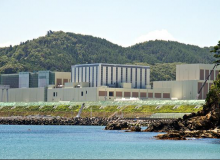
Editorial in The Mainichi (October 23, 2020)
Summary by Alejandro Reyes (Photo credit: IAEA)
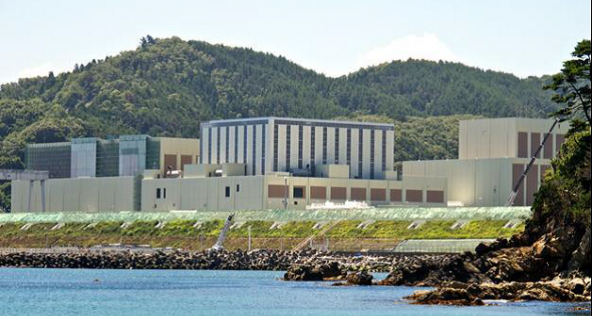
The Miyagi Prefectural Assembly has approved reactivation of the No. 2 unit of the Onagawa Nuclear Power Plant. The governor of the prefecture is set to make a final decision on the restart after hearing the opinions of the heads of local bodies involved. The plant's operator, Tohoku Electric Power Co., will accelerate moves to restart the reactor in two years. If it is reactivated, the Onagawa plant will be the first nuclear plant in a prefecture heavily damaged by the March 2011 Great East Japan Earthquake and tsunami to reboot one of its reactors.
The Nuclear Regulation Authority completed a safety inspection of the reactor in February. The municipal assemblies in Ishinomaki and Onagawa, which the plant straddles, have indicated that they will approve the restart.
But many issues remain unsolved. The government has asked local bodies within a 30-kilometer radius of nuclear power plants to formulate wide-area evacuation plans. In the case of the Onagawa plant, seven municipalities have mapped out such plans, but there are misgivings about their viability. Furthermore, among the five local municipalities excluding those which house the nuclear power plant, some are opposed to reactivation. In spite of this, consent of such local bodies has not been made a prerequisite to resume operations.
Lingering safety concerns cannot be swept away. The governor says that the plant adopted "the toughest regulations and standards in the world, and safety has increased". But Japan learned from the 2011 earthquake and tsunami that such disasters can exceed people's expectations.
Nuclear power plants are not 100 percent safe. Tohoku Electric and the prefectural government have a responsibility to listen to the concerns of residents and search for common ground. Rushing ahead to restart the reactor with consent as a mere formality while ignoring this responsibility is impermissible.

Solita Collas-Monsod, broadcaster, economist, writer and minister of economic planning of the Philippines (1986-1989), in her Get Real column in Philippine Daily Inquirer (October 17, 2020)
Summary by Alejandro Reyes (Photo credit: KAPATID on Twitter)
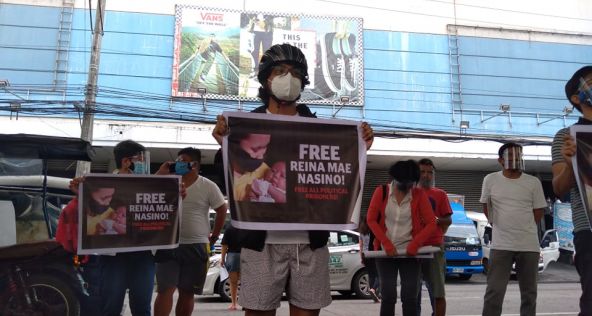
The case of social activist Reina Nasino and her baby River (who, separated from her jailed mother, died three months after she was born) has placed the Philippine justice system, nay, Philippine society, under trial by public opinion. And the verdict, it seems, is that both have failed.
Reina and her two companions say that the firearms and explosives, the possession of which led police to arrest them for a non-bailable offense, must have been planted. Police say otherwise. The police, based on “evidence” that they could have planted, put Reina in jail – an overcrowded one.
Reina finds out she is pregnant, and throughout that pregnancy, she is seen only once by a doctor, and is given no pregnancy supplements. But when she asks to be released on compassionate grounds, she is turned down again and again. She asks that her baby be allowed in her care. The judge turns down her request, because the jailers say they do not have the resources or facilities to accommodate them. The jail authorities cannot afford to keep her but they will not let her go. Why not release her in the first place? What threat to society could this 23-year-old pregnant woman and new mother possibly have represented?
The collective decision was to keep her in jail – probably on trumped-up charges. Never mind the consequences to her health, and to her baby’s life. To top it all was that scene at River’s wake, where there were more guards than mourners. That is how we treat our children. That is how we treat our prisoners. Shame.

Sanjaya Baru, Distinguished Fellow, The United Service Institution of India and the Institute of Defence Studies and Analyses, in The Indian Express (October 20, 2020)
Summary by Alejandro Reyes (Photo credit: BMN Network)

Fifty-eight years ago, Chinese troops entered the Indian territory to make a point. Historians and international relations scholars have spent half a century trying to explain that unexpected and first-ever war between the two Asian giants. The simple point that Mao Zedong tried to make at the time to Jawaharlal Nehru was that China did not regard India an equal. Fifty-eight years later, that is precisely the point that Xi Jinping has been trying to make to Narendra Modi.
In the 1950s, objective circumstances and material reality offered adequate reasons for Nehru to imagine that India was China’s equal and he, Mao’s. In 2020, Modi would be living in a make-believe world in case he harbored any such illusions. Xi wants him to get the message.
In the 1950s, and indeed till the turn of the century, there were good reasons for Indian leaders to view China as an equal. India under Modi finds itself in a better military and diplomatic space. The major power differential is economic and technological. Today, the Chinese economy is nearly five times the size of India’s in US dollar terms and almost two-and-a-half times India’s in purchasing power parity terms. In terms of Comprehensive National Power, which incorporates scientific and technological power and human capital formation, China out-ranks India many times over.
Xi’s confidence is based on the material foundations of Chinese power, requiring Modi to adopt a more cautious approach. For all the bravado of Modi’s domestic politics, he has so far walked a cautious diplomatic path, while keeping the powder dry. Modi cannot afford Nehru’s pretense for he can easily pay Nehru’s price. To regain global stature, India has to continue to focus on its domestic economic capability and human capital. There are no short cuts to global power and influence.

Phua Kok Khoo, Fellow of the American Physical Society and visiting professor in the physics departments of both National University of Singapore (NUS) and Nanyang Technological University (NTU), in Lianhe Zaobao (October 17, 2020)
Summary by Alan Yang Gregory (Photo credit: jdn2001cn0/Pixabay)

Singapore holds great ambitions to strengthen its higher-education sector and become a center of culture and learning.
One approach is to follow the British and American route, which is to focus on cultivating elite talent. Another approach emphasizes the widening of education to develop talent in science and technology and other fields. The embodiment of elitism in Singapore has been to provide top talents for national governance, including politics, science, technology, education and so on. In this regard, Singapore needs to work harder, both at home and abroad, while constantly reflecting on its own capabilities.
In relation to the field of science, while Singapore has not yet had any Nobel Prize winners, its achievements in technology are still remarkable. For example, it has many fellows in the Institute of Electrical and Electronics Engineers (IEEE). Nevertheless, the government should place greater emphasis on improving Singapore’s science capabilities. In addition, Singapore’s universities should provide greater support in academic research and support the pursuit of more outstanding objectives such as becoming a member of the National Academy of Sciences in the US or a fellow of the Royal Society in the UK.
The government should consider adjusting the direction of training in higher education. Singapore has cultivated many outstanding talents for governance and even the military. Singapore, however, should also support students in developing their academic expertise, particularly in science and technology. After all, this is also an important area for national development.

Elly Burhaini Faizal, Staff Writer, in The Jakarta Post (October 13, 2020)
Summary by Alejandro Reyes (Photo credit: Oberholster Venita/Pixabay)

Transmission of Covid-19 in Indonesia has continued unabated and expanded to malaria-endemic areas, especially the country’s eastern provinces, such as East Nusa Tenggara (NTT), Maluku and Papua, forcing authorities there to step up vigilance to prevent a double burden of disease. Plasmodium – a parasite that causes malaria in humans – can damage the immune system, which is why malaria patients are prone to other infections, including Covid-19. Health Ministry data in April revealed an upward trend of malaria incidences in Indonesia and an increasing number of high-malaria areas.
It will take more time and effort to combat the vector-borne disease because the ongoing coronavirus pandemic has laid a heavy burden on the healthcare system. With all attention and resources centered on Covid-19, the question is: Can Indonesia succeed in achieving its malaria elimination goal by 2030? There was a significant decrease in malaria cases from 2010 to 2014, according to Annual Parasite Incidence (API) data. But from 2014 to 2019, the control gains seemed to stagnate. Progress toward malaria control targets has stalled in some provinces, such as Papua, where a rise in the number of incidences has been reported. The high malaria incidence in some areas is a cause for concern particularly because there is no end in sight for the Covid-19 crisis.
Covid-19 poses a huge challenge to the malaria control and prevention program. Many health workers feared they would contract Covid-19 if they carried on with their field work. Similarly, the general public are reluctant to seek out health services for the same reason. Movement restrictions placed by authorities to curb the spread of Covid-19 had in fact affected the mass distribution of long-lasting insecticide bed nets, leaving the majority of at-risk communities unprotected from mosquito bites and increased transmission. Early and ongoing border restrictions between countries had resulted in disruptions to supply chains and raw material shortages, which later affected access to drugs and diagnostic tests for malaria.
With just only one decade left for the Asia-Pacific to achieve its malaria elimination goal, countries may need to take “unprecedented” measures to ensure malaria services such as case finding and disease treatment can continue running.

Kang Shin-wook, Commissioner of Statistics Korea (KOSTAT), in Money Today (October 5, 2020)
Summary by Soomi Hong (Photo credit: Design for Health)

October 9 is a national day for Hangul (the Korean alphabet). Although all Korean learn of King Sejong the Great, its creator, not many are aware that the venerated monarch was blind in his later years. Whereas the King sought to lift his people from illiteracy by creating a much easier way of writing, he himself had already lost his sight by the time Hangul was released to the public.
It is also not widely known that King Sejong actively promoted building an inclusive policy for the disabled. When his minister of interior who had a serious spine disability fell down the stairs during an official ceremony, it is said that the King had the stairs enlarged to not let the physical disability discourage his minister. King Sejong also approved giving official titles to musicians with disabilities and created professional public posts designed to give opportunities for the blind. Six hundred years ago, King Sejong was ahead of his time with his policy of inclusion.
According to the recent census, 26 percent (up by 4.5 percent from 2017) of respondents with disabilities ranked medical support as what they needed most, with 24.2 percent citing financial assistance and 18.7 percent (up by 8.7 percent from three years ago) help finding employment.
As the wise king sought to do six centuries ago, the hope is that statistics will help guide the implementation of policies for building a more inclusive and just society for all.

Fahd Husain, editor, in Dawn (October 10, 2020)
Summary by Alejandro Reyes (Photo credit: Prime Minister’s Office Islamic Republic of Pakistan)

Faced with the most potent threat since coming to power, the ruling Pakistan Tehreek-e-Insaf (PTI) party today runs the risk of tripping on what it has always considered its core strength. In the age of communication while fighting a war of communication, Prime Minister Imran Khan’s team may be falling victim to a failure of communication.
This failure can be encapsulated in three distinct points: (1) obsession with opposition at the expense of everything else; (2) obsession with opposition at the expense of everything else; (3) obsession with opposition at the expense of everything else. This everything else in turn can also be encapsulated in three distinct points: (1) failure to define core areas of strength; (2) failure to defend core areas of weakness; (3) failure to design the government’s vision in terms of what it is and not merely what it is not.
The fault lies not in its stars but in its strategy. Ever since he entered the political arena, Imran Khan had framed his identity in terms of what he was not – not corrupt, not dishonest, not a dynast, not in politics for business, not beholden to vested interests and not ready to compromise on principles for political expediency. He painted what he was not in reference to his predecessors. This framing was critical for his political branding.
It worked. But now the government is sagging under the weight of its innumerable spokespeople. The government’s army of ministers, advisers, special assistants and spokespeople have failed to communicate effectively because they are unable or unwilling to comprehend, contextualize and convey much beyond their bequeathed party DNA. It is easy to mock, taunt and sneer; not so easy to explain, elaborate and enumerate. The PTI is falling into its own communication trap.

Vrinda Shukla, Deputy Commissioner of Police, Crimes Against Women and Children, Indian Police Service, in Noida, Uttar Pradesh, in The Indian Express (October 8, 2020)
Summary by Alejandro Reyes

With only three days to go before her wedding, the bride-to-be received a call from her fiancé. Nothing could have prepared her for what he had to say. Hundreds of links had suddenly appeared on Instagram, Twitter and Facebook flashing extremely obscene pictures of the woman. Thus began a terrible nightmare for the hapless woman, her sole solace the strength of character and commitment of the groom-to-be.
The couple approached the police. It was a classic case of revenge porn – an invasion of sexual privacy and a form of online harassment where the perpetrator, usually a disgruntled ex-partner, posts intimate photos, often to shame the subject. The consequences for victims can be extreme, encompassing honor killings, breakdown of relationships, destruction of reputation and career, and immense emotional trauma.
While the police may succeed in prosecuting the perpetrators of such crimes, it can do little to clean up the mess left behind on the internet, the root cause of the victim’s suffering. Reporting such content by victims to social media platforms is often of no avail. Facebook receives half a million reports of revenge porn each month.
The dissemination of such photos and videos deserves to be defined as a sexual violation. It will then be considered a serious offence and encourage victims to report such crimes. Demanding accountability from social media giants is more important. Several countries have proposed tough laws on the issue, including imprisonment of their executives in extreme cases of non-compliance of requests made by law enforcement authorities.
With India having the world’s largest population of young people vulnerable to new mutations of deeply scarring sex crimes, the public-interest litigation filed in the Supreme Court is critical to establishing an efficient mechanism to remove sexually graphic abusive content and to seek accountability from social media platforms.

F Sionil José, writer, in his Hindsight column in The Philippine Star (October 5, 2020)
Summary by Alejandro Reyes (Photo credit: Rey Baniquet/Presidential Communications Operations Office)

With so many town fiestas and beauty pageants, it is perhaps not surprising that we have produced several beauties that have had global appeal. Indeed, our country is known for its beautiful women. But it is not just physical allure that makes them stand out. From way, way back our women were also leaders, strong and far ahead of most women in other countries. Our women were never fragile lilies. In our struggle against colonialism, they were revolutionaries, guerrillas. Now, they permeate all the professions.
In politics, we were never short of women who have served with commitment and virtue in government. Among them, in the postwar period, were first female senator Geronima Pecson; educator, writer and politician Leticia Ramos-Shahani; and academic, lawyer and political figure Miriam Defensor Santiago. Deputy Speaker of the House of Representatives Loren Legarda and retired associate justice of the Supreme Court Conchita Carpio-Morales are my candidates in the next election.
To this list I will single out Vice President Leni Robredo, whose magnificent sangfroid blunted all the slings and arrows of outrageous criticism. It has been a custom in the past for vice presidents – the so-called spare tire – to be given high positions in government. But belonging to a different party from the president’s, Leni was not granted that kind of distinction. A lawyer and former member of Congress, she would have been ideal as secretary of the Department of Social Welfare. Like her husband Jesse, who was a virtuous public official, she could have brought transparency to a government that is fogged with corruption.
We have so many women making all the difference, performing interesting jobs that contribute to the development of this nation.

Xie Yuhang, writer, in Oriental Daily (October 2, 2020)
Summary by Alan Yang Gregory (Photo credit: testing / Shutterstock.com)

Malaysia and China’s friendly relations have been built upon a long history of common interests and prosperity. In 2019, Malaysia became China’s second biggest trading partner among Southeast Asian nations.
In September 2013, China unveiled the Belt and Road Initiative (BRI), a development strategy to connect the East and the West, while repositioning China as a global trade and commercial center. China proposes to achieve this goal by addressing the infrastructure gap, such as investment in roads and ports, within emerging markets.
As a country whose main income is derived by exports, especially in the commodity trade and electronics/semiconductor supply chains, Malaysia’s economy is heavily exposed to sudden changes in market demand and prices. The urban-rural gap in Malaysia has exposed obvious systemic flaws. For Malaysia to develop further, the government needs to solve its own infrastructure gap. The BRI can help with this thanks to China's expertise in large-scale infrastructure development and development-financing institutions.
As the world gradually recovers from the pandemic, countries are thinking about the most effective recovery strategies. Both Malaysia and China have taken effective measures to control quickly the epidemic and resume economic activities. The progress may not be as fast as expected, because control measures remain in place and the borders are not open. The pace of recovery between Malaysia and China, however, is still faster than other countries.
It is not impossible for both countries to resume previous levels of economic growth. The Malaysian and Chinese governments should seek ways to enable the two countries to work more closely together on flagship projects to create greater value and win-win situations (such as the East Coast Railway). Through stronger Malaysia-China relations both countries can usher in a new generation of peace and prosperity for the 21st century.

Zhou Zhihuai, Executive Director, National Society of Taiwan Studies, in Global Times (September 21, 2020)
Summary by Alan Yang Gregory (Photo credit: Office of the President, Taiwan)

After Tsai Ing-wen and the Democratic Progressive Party (DPP) won the 2020 Taiwan elections, the debate over the issue of "peace and war" across the Taiwan Strait has become a prominent topic. Maintaining peace and ensuring the peaceful development of cross-strait relations have been consistently upheld by the Communist Party of China and its leadership. This highlights the mainland’s sincere desire for future generations on both sides to share a beautiful life in long-term peace
But this must be based on the common political foundation of "the mainland and Taiwan belonging to one China" and requires opposing "Taiwan independence". The mainland is resolutely against this precisely to avoid war and ensure that the country can achieve peaceful reunification. Ever since Lee Teng-hui came to power in 1988, conflicts in the political, foreign affairs and military fields have always stemmed from separatist activities.
After Tsai came to power, the situation has entered a new period of danger and peace has been increasingly challenged. While Tsai's administration has acted recklessly, "independence" forces have received strong external support. Since 2016, the US has strengthened its influence over Taiwan in terms of local politics and the military. It has used Taiwan as a “pawn” against China and tried to undermine any form of peaceful reunification. The long-term involvement of foreign forces is therefore a serious threat to peace.
Historically, people in Taiwan held no sense of the value of cross-strait peace, but now they are equally insensitive to the evolving crisis. Once peace is lost, neither the DPP nor external forces will be able to piece together the broken pieces. Peace on both sides of the strait is what the people want. Only when the Tsai can reaffirm the 1992 Consensus can the two sides resume dialogue to strengthen peace.

Lee Sang-hyun, Senior Research Fellow, Department of Security Strategy Studies, Sejong Institute, in Munhwa Ilbo (September 30, 2020)
Summary by Soomi Hong (Photo credit: Tomoyuki Mizuta/Pixabay)

The priority of any government must be to protect its citizens. But the outrageous response of the Korean government after a missing citizen was executed at gunpoint in North Korea seems to indicate otherwise for the current administration. A week after the incident, President Moon Jae-in expressed his condolences, “regardless of how or why the victim was found across border”. He utterly failed to attribute any responsibility to the DPRK. On the same day, the president’s party held a discussion on maintaining peace and restarting private tourism to the North. These inept and insensitive responses indicate three things.
First, the government utterly failed to save a citizen’s life by utilizing the communication channel existing between the two countries. The current government called for a through investigation of the then-president Park Geun-hye following the Sewol ferry accident. By the same logic, there must be a similar investigation into President Moon.
Second, the government should stop defending North Korea by simply citing leader Kim Jong-un’s “timely and repeated apology”. Instead, it must request a full investigation and a strong reprimand of those responsible. A simple apology should not constitute forgiveness when a citizen’s life was sacrificed.
Third, the government must see through the North Korean tactics. A day after Kim issued the apology for the shooting, the DPRK demanded a full stop to illegal crossing of the military demarcation line. For Pyongyang, the priority has always been the protection of the political status quo. This is not expected to change.
When the government fails to fulfill its basic duty, people have every right to be angry. The government must remember that it exists at the service of its own citizens before anything else.

Ye Jingwei (叶静薇), writer, in Sin Chew Daily (September 22, 2020)
Summary by Alan Yang Gregory (Photo credit: shankar s.)

The fact that Malaysians are multilingual often surprises foreigners. Many Malaysians can seamlessly switch from Malay, Malaysia’s official language, to English to their mother tongue or various local dialects. While this is an admirable feature of the country, it occasionally creates controversy.
In 2018, when the Minister of Transport Anthony Loke had a radio interview with a Cantonese broadcaster, he agreed to conduct the interview in Cantonese. Yet, he was condemned by those behind the Speak Mandarin Campaign. Yet, promoting Chinese should not mean speaking only Mandarin and rejecting all other dialects
After the current government came to power at the beginning of this year, when Deputy Minister of Education Mah Hang Soon took office, he was also criticized by netizens for his comments in Chinese on Facebook. In addition, the Anti-Corruption Commission set up a Chinese version of its official website, which attracted critics who pointed out that under the Constitution, all official content must be published in Malay. The website of the Ministry of Tourism, however, has versions in over ten languages. Is this also against the Constitution?
There is no question that Malay is the country’s official language, and it therefore makes sense to use Malay for official matters. Yet, in this case, the main purpose of the website was simply to convey information. The faster and easier it is to understand, the more convenient it is. After all, the online audience is not limited to just Malaysians.
Malaysians should prevent any actions that are xenophobic or hostile to speakers of other languages and instead allow all languages to blossom.

Ko Yu-chih, Associate Professor, Department of Diplomacy, National Chengchi University, in China Times (September 24, 2020)
Summary by Alan Yang Gregory (Photo credit: Wang Yu-ching/Office of the President, Taiwan)

On August 9, US Health and Human Services Secretary Alex Azar led a delegation to Taiwan. On September 17, a delegation led by Keith Krach, Under Secretary of State for Economic Growth, Energy, and the Environment, arrived in Taipei. The results of the two visits were mixed. Azar and Krach are the highest-ranking US officials to visit Taiwan since 1979. While Azar’s visit was open and formal, Krach’s was low-key and informal. This raises questions over the true intentions of the US.
The Azar delegation not only met President Tsai Ing-wen, but they also signed a memorandum of understanding (MoU) at the Central Epidemic Command Center (CECC). Meanwhile, the Krach delegation’s itinerary was not confirmed publicly beforehand and the format minimized intergovernmental meetings.
Azar’s delegation visited to discuss Covid-19 and public health cooperation, while Krach’s delegation was engaged in “funeral diplomacy”, attending the memorial service of former president Lee Teng-hui. The subsequent exchanges with the Ministry of Economic Affairs and the Ministry of Foreign Affairs on US-Taiwan economic cooperation took place on the sidelines.
The two delegations will provide a boost to the current government, given that Taiwan’s international recognition has been gradually reduced. The excessively low-key nature of the Krach delegation, however, highlights the caution of US diplomats in deepening economic relations and suggests that the Washington has no desire in provoking Beijing.
While Azar’s delegation signed a MoU, it did not cover vaccine cooperation, an area to which Taiwan is eager to contribute. Meanwhile, Krach’s delegation was particularly interested in Taiwan's screening of foreign investments. This could end up dragging Taiwan into the Sino-US trade war or giving the US the right to intervene in Taiwan’s investment review processes. The government must be cautious as this could ultimately make Taiwan more dependent on the US.

Richard Heydarian, Research Fellow at National Chengchi University in Taiwan, in his column Horizons in Philippine Daily Inquirer (September 22, 2020)
Summary by Alejandro Reyes (Photo credit: Bro Jeffrey Pioquinto, SJ)

“Only in the Philippines could a leader like Ferdinand Marcos, who pillaged his country for over 20 years, be considered for a national burial,” lamented the late Singaporean Prime Minister Lee Kuan Yew. “[Marcos] might have started off as a hero but ended up as a crook.”
What made Lee a legendary leader was his uncompromising work ethic, deep grasp of global geopolitics, ability to maintain optimal ties with both the West and the East, and zero tolerance for corruption and incompetence. Under his watch, Singapore developed one of the world’s centers of bureaucratic excellence. But even more impressive were his counterparts in neighboring Taiwan, South Korea and, later, post-Mao China. Unlike Marcos, or even Lee, the leaders of these countries oversaw the establishment of global brands and industries, from Hyundai (South Korea) to HTC (Taiwan) to Huawei (China).
So, what was the secret of their success? The first thing one notices is that it’s not about form of government or even type of regime. China remains a single-party communist regime, while Taiwan and South Korea, with their own unique presidential systems, have become even more dynamic since their transition to democracy in the 1980s.
Whether authoritarian or democratic, they have had remarkable economic performance. Clearly, it is not also about “race” or “culture” per se, since all of these countries were extremely poor just a few generations ago.
What is common in the success stories of these NICs (newly industrialized countries) is their well-organized, autonomous and competent bureaucracies, which have maintained national dynamism through proactive trade and industrial policies. The Philippines’ main problem is that it never had a “strong” state with a combination of “policy autonomy” and “functional capacity” to discipline the oligarchs and promote national interest.
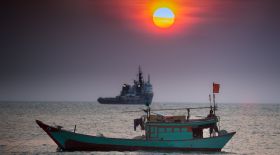

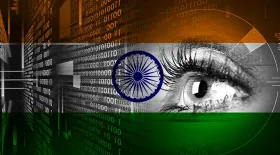

Asia Global Institute
The University of Hong Kong
Room 326-348, Main Building
Pokfulam, Hong Kong
asiaglobalonline@hku.hk
+852 3917 1297
+852 3917 1277
©2025 AsiaGlobal Online Journal
All rights reserved. Terms of Use - Privacy Policy.
Opinions expressed in pieces published by AsiaGlobal Online reflect those of the authors and do not necessarily represent the views of AsiaGlobal Online or the Asia Global Institute.
The publication of AsiaGlobal Voices summaries does not indicate any endorsement by the Asia Global Institute or AsiaGlobal Online of the opinions expressed in them.

Check out here for more research and analysis from Asian perspectives.
